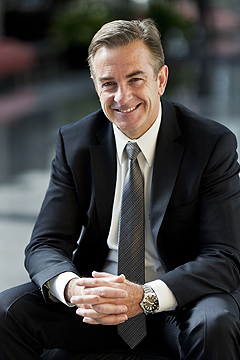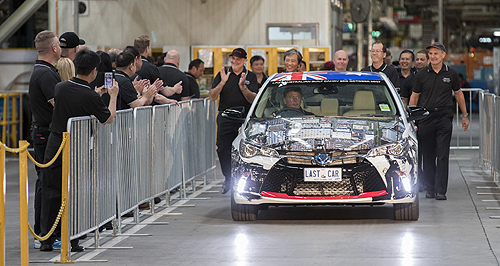Make / Model Search
News - ToyotaToyota exit: Market leader expects to hold sales, shareMedium rare: The next-generation Camry will be a more premium offering than the current car but the company is not expecting huge sales drops following the shift to a Japanese-built car. Impact on sales, brand perception unlikely to shift after factory closure: Toyota4 Oct 2017 TOYOTA Australia’s incoming president Matt Callachor says the closure of its local manufacturing operations will not hurt sales and market share or have a negative impact on its brand image in the way that it has affected both Ford and Holden. The market-leading automotive brand in Australia closed the gates to its Altona production facility in Melbourne’s west yesterday, bringing to a close 54 years of building cars in Australia. It follows Ford’s exit in October last year, while GM Holden will follow suit later this month, on October 20. Toyota has been the number-one-selling brand in Australia since 2003 when it sold 186,370 vehicles – enough to topple long-time leader Holden. Since then, the Japanese brand’s annual sales have hovered around the 200,000 mark. Last year, Toyota sold 209,610 units for a market share of 17.8 per cent, keeping well ahead of Holden on 94,308 units – enough for only fourth place in the market and an 8.0 per cent share – and Ford on 81,207 sales, which handed it fifth place and a 6.9 per cent market share. Since Ford and Holden’s announcements in May and December 2013 respectively that they were pulling out of Australian manufacturing, both car-makers have battled the perception that they were exiting the Australian market completely. Having long suffered from the downturn in Falcon sales, Ford now banks heavily on its Ranger pick-up and the Mustang muscle car, and is yet to fill the gap left by the Territory SUV. Holden is also in the process of rolling out a series of SUV and passenger car models that will make up for the expected drop in Commodore sales when the big Australian-built sedan is replaced with the German-built Insignia-based model in early 2018. Speaking with Australian journalists at Toyota headquarters in Port Melbourne last week, Mr Callachor said the company looked at the sales patterns of other car-makers that had closed their local manufacturing operations in recent years and concluded it was unlikely that Toyota sales would be hit hard by the factory closure. “We examined quite carefully those local manufacturers who had left the country, and it is fair to say the market share losses were quite large,” he said. “So from our viewpoint, having actually analysed why that was the case, we have been able to develop strategies that we feel confident that basically will ensure we have a minimum of 200,000 going on.” Nissan and Mitsubishi also shut their Australian factories in 1992 and 2008 respectively and both companies experienced a fall in market share. Mr Callachor said that Toyota’s broad model range meant that even if there was a dip in Camry sales with the change to a Japanese-sourced new-generation model, it would not have the same impact that some of Toyota’s rivals have experienced after closure. “The other thing you need to consider is that this year, for instance, our percentage of Camry sales within the total model mix is probably about 11 per cent – it is not that big as compared with some of those companies that have gone before in terms of their percentages that were up at 40 and 50 per cent,” he said. “I don’t see it in terms of sales – we were talking about 200,000 – I don’t see that changing, all our strategies are lined up towards that.”  Left: Incoming Toyota Australia president Matt Callachor Left: Incoming Toyota Australia president Matt CallachorMr Callachor acknowledged that, unlike Ford and Holden, many consumers were still unaware that Toyota built cars in Australia. “I don’t think we will see many people saying, ‘I won’t buy a Toyota because the factory has gone.’ They will still evaluate what is the best product for their requirements.” Toyota Australia executive director of sales and marketing Tony Cramb reiterated Mr Callachor’s comments and said the lack of recognition as an Australian car-maker was sometimes a frustration for the manufacturing staff. He added that not being seen as an Australian manufacturer in the same way as Ford and Holden has not harmed the brand or stymied sales. “It is a bit of a sore point between sales and marketing and manufacturing … that we could not get people to believe we manufactured them here,” he said. “In Toyota, we say this car is ‘Made in Toyota’, so actually where it is made should not matter. So from our point of view, we never focused on where it’s made and, you know, ‘football, meat pies and Holden cars’ – that kind of historical Aussie feeling towards the car companies. “We have never enjoyed that in that way. What we have enjoyed is in the rural communities and the working communities is a vehicle that will never let them down, it is actually part of the Outback, is part of Australia’s heritage, but not in the same way as Ford and Holden.” Outgoing Toyota Australia president Dave Buttner said the company did not face the issues Ford and Holden had in convincing consumers that it was not abandoning the market altogether. “I think 97 per cent of people recognised that we would still have a presence in the market. We did not do the research just once – we said, ‘We better keep checking this,’” he said. Mr Cramb added: “We did not face that issue so there was no need for us to deal with it in a public way. But honestly, there are still some people who still think that so we have to, in our messaging, keep talking about the vehicles, the experience and that sort of stuff.” More than half of Toyota’s sales come from fleet business and given some private and government organisations have mandated Australian-made cars as part of their fleet, pundits have suggested that Camry sales in particular could take a hit when the imported model arrives later this year. Mr Cramb said there was pressure on the manufacturing operation to maintain a level of 90,000 units annually for Australian sale and export, but as this would no longer be an issue, Toyota could dial back its aggressive pursuit of fleet business. “The extra volume we had to get from local manufacturing, that pressure is relieved, so perhaps we don’t dig as deep, but definitely we will be a big fleet player because, if you think of our customer base, there is a very healthy, strong customer base of mining companies, infrastructure companies, and big multinational companies that needs Toyotas to do their jobs. So, we will continue to do that,” he said. Mr Callachor said fleets and specifically taxi operators would continue to be an important part of Toyota’s overall business Down Under. “The taxi companies are buying the Camry because they like them, but because the hybrid is continuing on, so they will have that option. In terms of other fleet sales, with our large range of vehicles I feel that if they have a requirement, we will have a vehicle,” he said. Mr Buttner added that Toyota would still be the key volume player in the Australian market and that fleet business would always play a part in that. “The reality of the Australian marketplace is that if you are not in fleet, you are not going to get the volumes that we aspire to sell. I think you need 50 per cent fleet, 50 per cent private and in that fleet percentage, many act like a private buyer anyway because they are salary sacrifice or whatever,” he said. “We still have aspirations to sell a lot of vehicles so we still have to play in that space.” Mr Callachor admitted that the next-generation Camry would be a more premium offering than the outgoing version and suggested that any impact on Camry sales would be absorbed by the car-maker’s extensive model offerings, including its huge SUV line-up. “We are fortunate in Toyota in having such a large range of vehicles and I think you also have to take into account that the overall market is moving towards vehicles such as SUVs,” he said. “The Toyota range of SUVs is huge, so we can take care of future customer preferences.” When asked if Toyota would seek to rebrand itself or make any changes to marketing and advertising in the wake of the factory closure, Mr Callachor said there was no need to shift the strategy or make any physical changes at a dealership level. “No, it does not mean we will go away from the strengths we have – quality, dependability, reliability has always been our hallmark inside Toyota and I think it is one of the principal reasons so many people buy Toyotas in Australia,” he said. “I can tell you we are not going to walk away from that.” Mr Cramb added that the new marketing team would look to make some changes down the track, but he declined to detail any areas of weakness. “The only changes we are looking to make are ones where we feel we are weak, and those are at the niche level,” he said. “And we have an internal discussion going on about our brand and the development of our brand over the next five years, but the new team is working on that as we speak. “The outgoing team is working with the new team to ensure they fully understand the power of the brand that we already have, because it is pretty powerful. “Then, as Matt said, there is no point messing with that, but there are weaknesses that we have that we need to improve.”  Read more4th of October 2017  Toyota exit: More than 3.4 million cars made hereAfter 54 years, Toyota closes its factory doors with 3.4 million cars produced4th of October 2017  Toyota exit: Heavy casualties in supply chainJob losses run deep in Toyota supply chain but new doors open for parts-makers4th of October 2017  Toyota exit: Altona factory ends on a highAltona factory closes at the top of its game as Toyota details employee support4th of October 2017  Toyota exit: Engine plant headed overseasUnnamed Toyota affiliate to get Australian engine plant partly funded by taxpayers4th of October 2017  Toyota exit: TMC boss farewells Aussie plantAkio Toyoda expresses emotional thankyou to 2600 Toyota workers as Altona closes4th of October 2017  Toyota exit: 77 per cent of Sydney staff let goToyota’s sales and marketing transfer to Melbourne causes 280 job casualties16th of June 2017  Toyota Australia records $99 million annual profit$99m profit for Toyota Oz despite restructuring costs, unfavourable exchange rate10th of May 2017  Toyota puts Altona machinery up for saleGiant auto manufacturing equipment sale starts as Toyota shuts up shop in Oz31st of March 2017  Mass exodus of top Toyota execs at year’s endFive top executives with 145 years’ experience between them are set to leave Toyota31st of January 2017  Toyota confirms manufacturing end dateFinal Australian-built Camry to roll off Toyota’s production line on October 310th of January 2017  Detroit show: New Toyota Camry to come from JapanNew beginning for Toyota Camry as sleek replacement to be imported from Japan3rd of August 2016  Toyota commits to late-2017 engine plant closureEngine plant to continue until late 2017 as Toyota Technical Centre closes |
Click to shareToyota articlesResearch Toyota Motor industry news |











Facebook Twitter Instagram